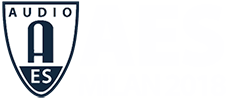AES Milan 2018
Poster Session P09
P09 - Posters: Perception
Thursday, May 24, 10:00 — 11:30 (Arena 2)
P09-1 Sound Localization of Beamforming-Controlled Reflected Sound from Ceiling in Presence of Direct Sound—Hiroo Sakamoto, The University of Electro-Communications - Chofu, Tokyo, Japan; Yoichi Haneda, The University of Electro-Communications - Chofu-shi, Tokyo, Japan
Sound localization from the ceiling is important for 3D surround-sound systems, such as Dolby Atmos, 22.2 channel and higher-order ambisonics. Such systems are difficult to set up in a typical home environment owing to loudspeakers that must be placed on the ceiling. This problem can be solved by using the reflected sound from the ceiling through loudspeaker-array beamforming, such as in commercial sound bars. In the beamforming method, the listener always hears the jammer sound (side lobe) before he/she hears the main sound from the ceiling. To date, the relationship between the time and level differences in the direct and reflected sounds for sound image localization at the reflected position on the ceiling is not clear. This paper investigates this relationship through listening experiments. We also confirmed the localization at the ceiling by using a 32-element spherical loudspeaker array.
Convention Paper 9949 (Purchase now)
P09-2 Evaluation of Player-Controlled Flute Timbre by Flute Players and Non-Flute Players—Mayu Kasahara, Tokyo University of the Arts - Tokyo, Japan; Atsushi Marui, Tokyo University of the Arts - Tokyo, Japan; Toru Kamekawa, Tokyo University of the Arts - Adachi-ku, Tokyo, Japan
In order to investigate how flute players and non-flute players differ in the perception of the instrument, two listening experiments were carried out. The flute sounds were recorded to have changes in five levels of harmonic overtones energy levels played by three flute players. Through a listening experiment of attribute rating on “brightness,” the flute players were found to evaluate the stimuli “brighter” as the harmonic overtones energy decreased while the non-flute players evaluated inversely. Through the second listening experiment of pairwise global dissimilarity rating among the stimuli, two dimensions corresponding to the harmonic overtones energy levels and to the noise levels were found. The experience of the flute performance did not seem to affect the result. These results indicate that the experience of the flute performance seemed to affect the result only when evaluating the stimuli using the word “brightness.”
Convention Paper 9950 (Purchase now)
P09-3 Comparing the Effect of Audio Coding Artifacts on Objective Quality Measures and on Subjective Ratings—Matteo Torcoli, Fraunhofer Institute for Integrated Circuits IIS - Erlangen, Germany; Sascha Dick, International Audio Laboratories Erlangen, a joint institution of Universität Erlangen-Nürnberg and Fraunhofer IIS - Erlangen, Germany; Fraunhofer Institute for Integrated Circuits IIS - Erlangen, Germany
A recent work presented the subjective ratings from an extensive perceptual quality evaluation of audio signals, where isolated coding artifact types of varying strength were introduced. We use these ratings as perceptual reference for studying the performance of 11 well-known tools for objective audio quality evaluation: PEAQ, PEMO-Q, ViSQOLAudio, HAAQI, PESQ, POLQA, fwSNRseg, dLLR, LKR, BSSEval, and PEASS. Some tools achieve high correlation with subjective data for specific artifact types (Pearson's r > 0.90, Kendall's t > 0.70), corroborating their value during the development of a specific algorithm. Still, the performance of each tool varies depending on the artifact type and no tool reliably assesses artifacts from parametric audio coding. Nowadays, perceptual evaluation remains irreplaceable, especially when comparing different coding schemes introducing different artifacts.
Convention Paper 9951 (Purchase now)
P09-4 On the Accuracy and Consistency of Sound Localization at Various Azimuth and Elevation Angles—Maksims Mironovs, University of Huddersfield - Huddersfield, West Yorkshire, UK; Hyunkook Lee, University of Huddersfield - Huddersfield, UK
This study examined the sound localization of a broadband pink noise burst at various azimuth and elevation angles in a critical listening room. A total of 33 source positions were tested, ranging from 0° to 180° azimuth and -30° to 90° elevation angles with 30° intervals. Results indicated that sound source elevation was localized inaccurately with a large data spread; however, it was improved on the off-center planes. It was observed that elevation localization accuracy was worse on the back compared to the front. Back to front confusion was observed for the sources raised to 60° elevation angle. Proposed listening response method showed consistent localization result and is therefore considered to be useful for future studies in 3D sound localization.
Convention Paper 9952 (Purchase now)
P09-5 Examination of the Factors Influencing Binaural Rendering on Headphones with the Use of Directivity Patterns—Bartlomiej Mróz, Gdansk University of Technology - Gdansk, Poland
This paper presents a study on the influence of the directional sound sources with the use of the directivity patterns. This contribution also includes a comparison to the work done by Wendt et al. where several directivity pattern designs used to gradually control the auditory source distance in a room were showed. While the tests of Wendt et al. were done by auralizing source and room using a loudspeaker ring in an anechoic chamber, this study aims at investigating whether the effect performs similarly in binaural auralization over headphone playback. The study includes not only the auditory source distance but also tries to discover the influence of auralized room characteristics, source-to-receiver distance, and signal on auditory externalization.
Convention Paper 9953 (Purchase now)
